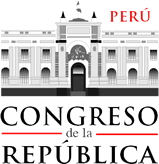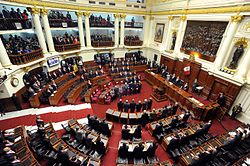
Back مجلس شيوخ بيرو Arabic Congresu de la República del Perú AST Кангрэс Рэспублікі Перу Byelorussian Congrés de la República del Perú Catalan Kongress der Republik Peru German Kongreso de la Respubliko Peruo Esperanto Congreso de la República del Perú Spanish Congrès de la République (Pérou) French הקונגרס של פרו HE Kongres Republik Peru ID
12°02′53″S 77°01′30″W / 12.04806°S 77.02500°W
Congress of the Republic Congreso de la República | |
|---|---|
| Period 2021–2026 | |
 | |
| Type | |
| Type | |
| Established | 20 September 1822 (First Constituent Congress) 26 July 1995 (1995 Peruvian general election) |
| Leadership | |
President of Congress | |
1st Vice President of Congress | |
2nd Vice President of Congress | |
3rd Vice President of Congress | |
| Structure | |
| Seats | 130 |
 | |
Political groups |
|
| Salary | S/187,200 Annually |
| Elections | |
| Constituencies using proportional representation with a 5%[1] threshold | |
Last election | 11 April 2021 |
Next election | 2026 |
| Meeting place | |
 | |
| Palacio Legislativo Plaza Bolívar, Lima Republic of Peru | |
| Website | |
| congreso | |
The Congress of the Republic of Peru (Spanish: Congreso de la República) is the unicameral body that assumes legislative power in Peru. Due to broadly interpreted impeachment wording in the Constitution of Peru, the President of Peru can be removed by Congress without cause, effectively making the legislature more powerful than the executive branch.[2][3] Following a ruling in February 2023 by the Constitutional Court of Peru, the body tasked with interpreting the Constitution of Peru and whose members are directly chosen by Congress, judicial oversight of the legislative body was also removed by the court, essentially giving Congress absolute control of Peru's government.[4][5][6] Since the 2021 Peruvian general election, right wing parties held a majority in the legislature.[7][8][9] The largest represented leftist party in Congress, Free Peru, has subsequently aligned itself with conservative and Fujimorists parties within Congress due to their institutional power.[10]
Congress's composition is established by Chapter I of Title IV of the Constitution of Peru. Congress is composed of representatives who sit in congressional districts allocated to each region, as well as two special districts, Lima Province and Peruvian citizens living abroad, on a basis of population as measured by the Peruvian Census in multi-member districts. The number of voting representatives is fixed by the Constitution at 130. Pursuant to the 2017 Census, the largest delegation is that of Lima Province, with 36 representatives.
Congress is charged with the responsibility to pass laws and legislative resolutions, as well as to interpret, amend, or repeal existing laws. Congress also ratifies international treaties, approves the national budget, and authorizes loans on behalf of the country. It may also override presidential observations to bills by a vote of more than half the legal number of congressmen. It can also remove government official including the President, consent to the entry of foreign troops into the national territory, and authorize the President to leave the country. Congress meets at the Legislative Palace in Lima.
The presiding officer is the President of Congress, who is elected by the members thereof (and is therefore traditionally the leader of the controlling party). The President and three vice-presidents are chosen by the controlling governing coalition.
- ^ "Peru's small political parties scramble to survive".
- ^ Asensio, Raúl; Camacho, Gabriela; González, Natalia; Grompone, Romeo; Pajuelo Teves, Ramón; Peña Jimenez, Omayra; Moscoso, Macarena; Vásquez, Yerel; Sosa Villagarcia, Paolo (August 2021). El Profe: Cómo Pedro Castillo se convirtió en presidente del Perú y qué pasará a continuación (in Spanish) (1 ed.). Lima, Peru: Institute of Peruvian Studies. p. 92. ISBN 978-612-326-084-2. Retrieved 17 November 2021.
- ^ Taj, Mitra (7 December 2021). "'Too many mistakes': Peru's president threatened with impeachment after shaky start". Financial Times. Retrieved 13 December 2021.
- ^ Romero, César (28 February 2023). "Tribunal Constitucional falla a favor del Congreso, que tendrá un poder absoluto y sin control judicial". La República (in Spanish). Retrieved 2 March 2023.
- ^ Romero, César (25 February 2023). "El Tribunal Constitucional está destruyendo el régimen democrático del país". La República (in Spanish). Retrieved 2 March 2023.
- ^ Cárdenas, Abel (5 March 2023). "Congreso doblega el equilibrio de poderes en medio de la convulsión social en Perú". Ojo Público (in Spanish). Retrieved 28 March 2023.
- ^ • "Peru's Castillo will struggle to stay in office". Oxford Analytica. Emerald Expert Briefings. oxan–db (oxan–db). 11 August 2022. doi:10.1108/OXAN-DB272027.
The far-right parties in Congress -- Renovacion Popular (Popular Renewal) and Avanza Pais (Forward Country)
- Vásquez, Jorge Rendón (10 April 2022). "Desmanes en las calles: la ultraderecha está jugando con la gasolina... y con el fuego". El Búho (in Spanish). Retrieved 30 April 2023.
The far right, personified in Congress by 43 representatives of the groups Fuerza Popular, Renovación Popular and Avanza País and some of their center allies
- "Así se movieron los votos en el Congreso para darle la ajustada confianza al gabinete de Aníbal Torres". LaMula (in Spanish). 2022. Retrieved 30 April 2023.
Far-right: Fuerza Popular since then marked its line of voting against all the cabinets that Pedro Castillo names from now on. ... To these votes against were added those of Popular Renewal and Avanza País
- "Perú: nuevo intento destituyente en contra de Pedro Castillo | El Congreso aprobó una moción para derrocarlo, la tercera en 16 meses". Pagina 12 (in Spanish). 2 December 2022. Retrieved 17 January 2023.
tres partidos de derecha radical -Fuerza Popular, Renovación Popular y Avanza País
- Vásquez, Jorge Rendón (10 April 2022). "Desmanes en las calles: la ultraderecha está jugando con la gasolina... y con el fuego". El Búho (in Spanish). Retrieved 30 April 2023.
- ^ Tegel, Simeon (27 March 2023). "Peru's First Female President Has Blood on Her Hands". Foreign Policy. Retrieved 6 June 2023.
social conservatism, which has been one of the few areas of common ground between Free Peru's presidential administrations and the hard-right congressional majority
- ^ "Ofensiva contra los fiscales del caso Lava Jato". IDL Reporteros (in Spanish). 16 July 2023. Retrieved 30 July 2023.
Fuerza Popular is an important part of the far-right coalition that controls Congress
- ^ "Ni siquiera topo: apenas tapón". IDL-Reporteros (in Spanish). 22 May 2023. Retrieved 26 May 2023.